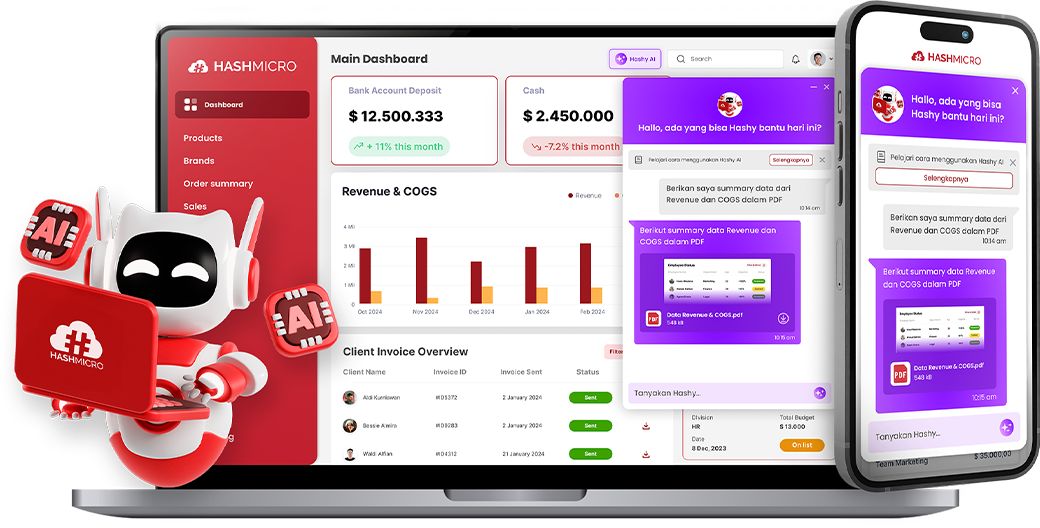Over 90% of top-performing financial institutions have already used AI to improve operations, risk management, and service delivery. And yet, many companies still struggle to apply AI meaningfully beyond the buzzwords and into real results.
AI in finance isn’t merely a trend; it’s a response to growing pressure for faster decisions, tighter compliance, and more personalized customer experiences. As financial data becomes more complex, AI offers the speed and insight traditional systems simply can’t match.
From fraud detection and credit scoring to automated financial reporting and predictive analytics, this article breaks down how AI is transforming the finance industry, and how tools like Hashy AI can help your business unlock its full potential.
Key Takeaways
|
Table of Content
Content Lists
What is AI in Finance?
Artificial intelligence (AI) in finance refers to the use of technologies like machine learning (ML), natural language processing (NLP), and predictive analytics to handle complex financial tasks. These include fraud detection, credit scoring, algorithmic trading, risk assessment, and customer service automation.
Instead of relying solely on manual processes or static systems, financial institutions are now turning to AI to process vast datasets, uncover patterns, and make faster, more accurate decisions.
In addition, tools like chatbots and virtual assistants are elevating customer service, while automated data collection supports quicker, more informed decision-making.
Beyond automation, AI also enables financial firms to gain deeper insights into customer behavior. It can also deliver personalized recommendations and facilitate more human-like interactions. As a result, financial services become faster, smarter, and more customer-centric.
Benefits of AI in Finance Industry
While we’re still seeing the full long-term effects of AI in banking unfold, its benefits are already clear in several key areas:
1. Greater Efficiency and Cost Savings
AI automation helps banks speed up routine processes like loan approvals, fraud detection, and customer support. In wealth management, AI improves efficiency, broadens access to services, and gives better insights into client behavior—cutting operational costs by millions.
One real-world example: JPMorgan Chase reported a 20% drop in account validation rejections thanks to AI-enhanced payment screening, which led to major savings.
2. Better Risk Management
AI can quickly scan and analyze huge volumes of data to assess credit risk and detect fraud more accurately. This helps reduce loan defaults, cut down risk provisions, and improve profit margins. Furthermore, AI-driven risk assessment can lead to significant cost savings for banks.
3. Higher Revenue Potential
AI tools can personalize financial products based on customer preferences, boosting satisfaction and loyalty. They can also spot new sales opportunities and improve marketing strategies.
For instance, Bank of America uses AI to suggest tailored investment plans—encouraging customer engagement and product uptake.
Essential Stakeholders in Financial AI Ecosystems
AI in finance requires the people and institutions to make it work. These key stakeholders shape how AI is designed, deployed, and governed within the financial landscape.
1. Financial Institutions and Executives
Banks, investment firms, and insurance companies use AI to enhance operations, manage risks, and boost customer engagement. Executives are responsible for aligning AI initiatives with business objectives, whether it’s fraud detection, portfolio optimization, or client services.
2. AI Developers and Data Scientists
These professionals design and refine AI models tailored for financial use cases. They train systems using real-world financial data, improve accuracy, and ensure ethical standards are met—particularly in areas like automated decision-making and risk scoring.
3. Regulatory Bodies and Legal Teams
Organizations like Bank Negara Malaysia and the Securities Commission play a key role in regulating AI usage. Legal teams work to ensure compliance with AML rules, personal data protection, consumer rights, and AI ethics.
4. Risk and Compliance Teams
These teams rely on AI to monitor real-time data, flag irregularities, and streamline regulatory reporting. By automating risk analysis and compliance checks, AI helps financial institutions maintain security and stay within regulatory boundaries.
5. Ethics and Diversity Officers
To ensure AI systems are fair and unbiased, ethics officers review algorithms for transparency and inclusivity. They advocate for equitable practices in areas like loan approvals, credit scoring, and investment advice.
6. Customers
As end users of AI-driven tools like robo-advisors and chatbots, customers influence the success of AI adoption. Their feedback, trust, and concerns—especially around privacy—play a major role in shaping future improvements.
7. Auditors and Internal Control Teams
These stakeholders review AI systems to ensure they are secure, accurate, and compliant with standards. Internal audits help identify vulnerabilities, support transparency, and reinforce accountability in AI applications.
Use Cases of AI in Finance Industry

A wide range of financial institutions are now using AI to boost efficiency, enhance decision-making, and improve user experience. Here are 12 common ways AI is being applied in the finance industry, although it’s just the tip of the iceberg:
1. Algorithmic Trading
AI is used to build trading systems that scan real-time market data and historical trends to place trades at the most strategic times. For example, some investment firms use AI to adjust portfolios within milliseconds based on global news or stock price volatility.
2. Workflow Automation
From reconciling bank statements to flagging unusual transactions, AI streamlines tasks that would normally take hours of manual work. Insurance companies, for instance, use AI to process claims faster and reduce approval delays.
3. Compliance Monitoring
Financial institutions use AI tools to track regulatory changes and automate reporting. This helps them stay compliant with rules like AMLA in Malaysia, reducing the risk of penalties and audit issues.
4. Credit Risk Assessment
Instead of relying only on traditional credit scores, lenders now use AI to evaluate applicants by analyzing mobile usage patterns, e-commerce history, or even bill payment behavior—making credit more accessible to groups that need it.
5. Cost Efficiency
By cutting down on paperwork, reducing human error, and speeding up back-end operations, AI reduces the need for large support teams. For example, digital banks use AI to handle customer onboarding without needing physical branches.
6. Customer Experience
AI-powered chatbots now handle tasks like resetting passwords, giving instant loan eligibility checks, or providing spending insights. Banks like CIMB and Maybank use this tech to reduce wait times and offer support 24/7.
7. Financial Data Analysis
AI helps banks and fintech firms sift through customer spending, market trends, and investment patterns to uncover insights that would be hard to spot manually. This helps with everything from personalized marketing to strategic planning.
8. Fraud Prevention
AI is widely used in Malaysia to monitor transactions in real time. For example, banks use AI to detect phishing attempts, identify unusual login behavior, and prevent unauthorized credit card activity—improving digital banking security overall.
9. Portfolio Management
AI supports portfolio optimization by analyzing market movements and economic indicators. It helps investors make timely adjustments to improve performance and manage risk exposure.
10. Predictive Analytics
Through predictive modelling, AI enables financial institutions to anticipate market changes, detect early signs of risk, and better understand evolving customer behavior.
11. Risk Management
AI enhances risk detection by analyzing transactional and historical data to uncover patterns, anomalies, and potential vulnerabilities—leading to stronger risk controls.
12. Sentiment Analysis
By evaluating news sources, forums, and social media, AI helps interpret market sentiment, offering valuable insights that influence investment and trading decisions.
What is Machine Learning in Finance?
Machine Learning (ML) is a key branch of artificial intelligence (AI) that enables computers to process large amounts of data, recognize patterns, and make decisions—without being explicitly programmed. In finance, ML is making a significant impact in several practical areas:
1. Predictive Analytics
ML uncovers trends in historical financial data, such as stock price movements, currency fluctuations, and economic shifts. These insights help traders and investors anticipate market changes and make more informed investment decisions.
2. Customer Behavior Analysis
By examining transaction histories and spending habits, ML allows banks and financial platforms to deliver personalized services. This includes recommending suitable investment products and detecting suspicious activity that may signal fraud.
3. Automation of Financial Reporting
Tasks like generating financial statements or conducting risk assessments, which once required significant manual effort, can now be automated using ML—saving time and improving accuracy.
With AI becoming more embedded in financial systems, many accounting software solutions now come with built-in ML capabilities.
For example, HashMicro offers AI-powered features such as automated reporting and Peppol e-Invoicing with a competitive price. Click the banner below to learn more!

The Future of AI in Financial Services
The future of AI in finance is shaping up to make the industry faster, safer, and more customer-friendly. Banks and financial institutions are already using AI to improve how they make decisions, automate repetitive tasks, and detect fraud more effectively.
As more companies adopt AI, financial management tools will get even smarter—handling things like budgeting, forecasting, and compliance with less manual effort. That means fewer errors, faster processes, and real-time insights to support better business decisions.
AI is also helping banks personalize their services, offering products that actually fit what each customer needs based on their habits and preferences.
In the years ahead, we can expect AI to play an even bigger role in guiding investment decisions, spotting trends early, and managing risks more accurately. All in all, finance is heading toward a future that’s more efficient, secure, and tailored to the people it serves.
Enhance Financial Management with Hashy AI

Managing finances isn’t just about sending invoices anymore. It’s about staying on top of receivables, keeping vendor relationships smooth, and making smart decisions with real-time insights.
That’s exactly what Hashy AI, HashMicro’s AI-powered finance assistant, is built for.
1. Smarter AR Collections
No more awkward manual chasing. Hashy supports AR Collectors by automatically following up with customers on overdue invoices or Statements of Account (SoA).
You can even create invoices on the go, perfect for teams that are constantly in motion. With Hashy, your receivables process becomes proactive, not reactive.
2. Better AP Management
Accounts Payable teams can also rely on Hashy to communicate with vendors on payment status and updates—without the back-and-forth emails. This keeps your vendor relationships strong and your payable cycle transparent.
3. Powerful Financial Insights
Hashy also supports financial analysts with meaningful insights. You get access to budget planning tools based on historical trends, and you can easily run reconciliations between your system and actual bank statements.
Conclusion
AI is transforming finance by improving efficiency, reducing risk, and delivering more personalized, data-driven decision-making. From fraud detection to forecasting, it helps institutions move faster, smarter, and with greater confidence.
With Hashy AI, you don’t just automate tasks. Rather, you empower your finance team to work with real-time clarity. From smarter collections to seamless reporting, Hashy brings the speed and control your business needs.
If you’re ready to simplify your finance operations, it’s time to see Hashy in action today. Experience how effortless cash flow, vendor management, and insights can be; try the free demo now!

Frequently Asked Questions on AI in Finance
-
What are the ethical challenges of applying AI in finance?
Implementing AI in finance raises ethical concerns, particularly regarding discrimination based on sensitive attributes. Complex AI decision-making processes can lack transparency, making it difficult to identify biases that may lead to unfair treatment of individuals in areas like loan approvals or credit scoring.
-
Will AI replace financial analysts in the future?
While AI can automate data processing and routine tasks, it lacks the lateral thinking and creativity required for high-level analysis. Therefore, AI is seen as a tool to augment analysts’ capabilities rather than replace them, allowing professionals to focus on strategic decision-making.
-
What role does AI play in personal finance management?
AI is increasingly integrated into personal finance through applications like budgeting tools and robo-advisors. These AI-driven apps help individuals track expenses, identify unnecessary costs, and manage investments. However, while AI excels at data analysis, it may not yet provide the personalized financial advice that a human advisor can offer.
-
How is AI utilized in anti-money laundering (AML) efforts?
AI enhances AML efforts by analyzing large datasets to detect unusual patterns and flag potential fraudulent activities. For instance, AI systems can monitor transactions in real-time to identify behaviors indicative of money laundering.




































